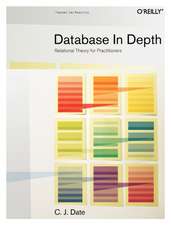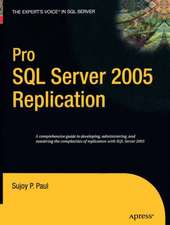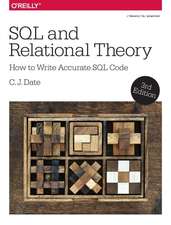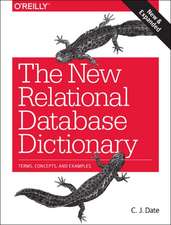Database Design and Relational Theory: Normal Forms and All That Jazz
Autor C. J. Dateen Limba Engleză Paperback – 16 dec 2019
Create database designs that scale, meet business requirements, and inherently work toward keeping your data structured and usable in the face of changing business models and software systems.
This book is about database design theory. Design theory is the scientific foundation for database design, just as the relational model is the scientific foundation for database technology in general. Databases lie at the heart of so much of what we do in the computing world that negative impacts of poor design can be extraordinarily widespread.
This book aims to be different from other books on design by bridging the gap between the theory of design and the practice of design. The book explains theory in a way that practitioners should be able to understand, and it explains why that theory is of considerable practical importance. Reading this book provides you with an important theoretical grounding on which to do the practical work of database design. Reading the book also helps you in going to and understanding the more academic texts as you build your base of knowledge and expertise. Anyone with a professional interest in database design can benefit from using this book as a stepping-stone toward a more rigorous design approach and more lasting database models.
What You Will Learn
- Understand what design theory is and is not
- Be aware of the two different goals of normalization
- Know which normal forms are truly significant
- Apply design theory in practice
- Be familiar with techniques for dealing with redundancy
- Understand what consistency is and why it is crucially important
Who This Book Is For
Those having a professional interest in database design, including data and database administrators; educators and students specializing in database matters; information modelers and database designers; DBMS designers, implementers, and other database vendor personnel; and database consultants. The book is product independent.
| Toate formatele și edițiile | Preț | Express |
|---|---|---|
| Paperback (2) | 207.88 lei 3-5 săpt. | +20.30 lei 6-10 zile |
| O'Reilly – 7 mai 2012 | 207.88 lei 3-5 săpt. | +20.30 lei 6-10 zile |
| Apress – 16 dec 2019 | 274.18 lei 3-5 săpt. |
Preț: 274.18 lei
Preț vechi: 342.72 lei
-20% Nou
Puncte Express: 411
Preț estimativ în valută:
52.46€ • 57.17$ • 44.21£
52.46€ • 57.17$ • 44.21£
Carte disponibilă
Livrare economică 02-16 aprilie
Preluare comenzi: 021 569.72.76
Specificații
ISBN-13: 9781484255391
ISBN-10: 1484255399
Pagini: 451
Ilustrații: XIX, 451 p. 59 illus.
Dimensiuni: 178 x 254 x 34 mm
Greutate: 0.81 kg
Ediția:Second Edition
Editura: Apress
Colecția Apress
Locul publicării:Berkeley, CA, United States
ISBN-10: 1484255399
Pagini: 451
Ilustrații: XIX, 451 p. 59 illus.
Dimensiuni: 178 x 254 x 34 mm
Greutate: 0.81 kg
Ediția:Second Edition
Editura: Apress
Colecția Apress
Locul publicării:Berkeley, CA, United States
Cuprins
Part I. Setting the Scene.- Chapter 1. Preliminaries.-Chapter 2. Prerequisites.- Part II. Functional Dependencies, Boyce/CODD Normal Form, and Related Matters.- Chapter 3. Normalization: Some Generalities.- Chapter 4. FDs and BCNF (Informal).- Chapter 5. FDs and BCNF (Formal).- Chapter 6. Preserving FDs.- Chapter 7. FD Axiomatization.- Chapter 8. Denormalization.- Part III. Join Dependencies, Fifth Normal Form, and Related Matters.- Chapter 9. JDs and 5NF (Informal).- Chapter 10. JDs and 5NF (Formal).- Chapter 11. Implicit Dependencies.- Chapter 12. MVDs and 4NF.- Part IV. Further Normal Forms.- Chapter 13. ETNF, RFNF, SKNF.- Chapter 14. 6NF.- Chapter 15. The End Is Not Yet.- Part V. Orthogonality.- Chapter 16. The Principle of Orthogonal Design.- Part VI. Redundancy.- Chapter 17. We Need More Science.- Part VII. Appendixes.- Chapter 18: Appendix A. What Is Database Design, Anyway?.- Chapter 19: Appendix B. More on Consistency.- Chapter 20: Appendix C. Primary Keys Are Nice but Not Essential.- Appendix D. Historical Notes.
Notă biografică
CJ Date is an independent author, lecturer, researcher, and consultant, specializing in relational database technology, a field he helped pioneer. Prior to leaving IBM in 1983, he was involved in technical planning and externals design for the IBM products SQL/DS and DB2. His book An Introduction to Database Systems (8th edition) is the standard text on the subject and has sold 900,000 copies, not counting translations. It is used by several hundred colleges and universities worldwide. Mr. Date has delivered live lectures and seminars on database matters at locations throughout the world. He holds an honors degree in mathematics from Cambridge University and has made a number of original contributions to database theory. He enjoys a reputation that is second to none for his ability to explain complex technical issues in a clear and understandable fashion.
Textul de pe ultima copertă
Create database designs that scale, meet business requirements, and inherently work toward keeping your data structured and usable in the face of changing business models and software systems.
This book is about database design theory. Design theory is the scientific foundation for database design, just as the relational model is the scientific foundation for database technology in general. Databases lie at the heart of so much of what we do in the computing world that negative impacts of poor design can be extraordinarily widespread.
This book aims to be different from other books on design by bridging the gap between the theory of design and the practice of design. The book explains theory in a way that practitioners should be able to understand, and it explains why that theory is of considerable practical importance. Reading this book provides you with an important theoretical grounding on which to do the practical work of database design. Reading the book also helps you in going to and understanding the more academic texts as you build your base of knowledge and expertise. Anyone with a professional interest in database design can benefit from using this book as a stepping-stone toward a more rigorous design approach and more lasting database models.
You will:
- Understand what design theory is and is not
- Be aware of the two different goals of normalization
- Know which normal forms are truly significant
- Apply design theory in practice
- Be familiar with techniques for dealing with redundancy
- Understand what consistency is and why it is crucially important
Caracteristici
Covers all normal forms in depth up to the sixth normal form Describes aspects of design theory such as dependency preservation and orthogonality Provides friendly examples of theory without sacrificing accuracy or precision Focuses on timeless principles that are relevant for as long as databases continue to exist
Descriere
Descriere de la o altă ediție sau format:
Because databases often stay in production for decades, careful design is critical to making the database serve the needs of your users over years, and to avoid subtle errors or performance problems. In this book, CJ Date, a leading exponent of relational databases, lays out the principles of good database design.
Because databases often stay in production for decades, careful design is critical to making the database serve the needs of your users over years, and to avoid subtle errors or performance problems. In this book, CJ Date, a leading exponent of relational databases, lays out the principles of good database design.





















